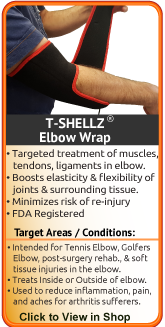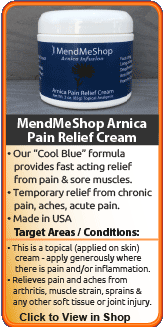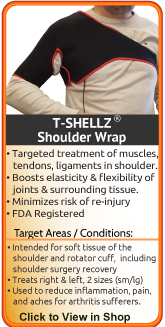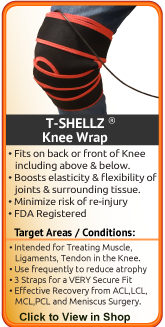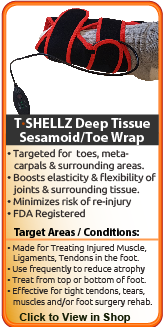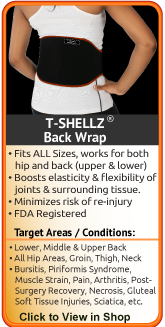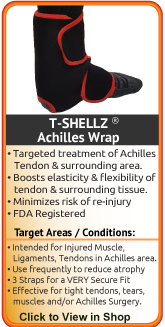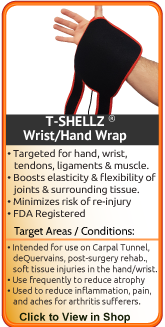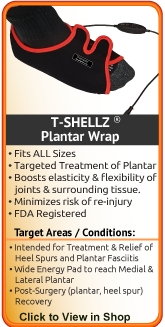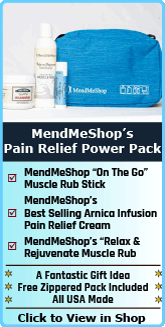Ice vs Heat for Treating Muscle Pain
When it comes to using ice and heat for treating a soft tissue injury, it's important to keep in mind that both ice AND heat are very effective ways to relieve pain and heal. Most people will think one is better over the other from their own experience or what a doctor or PT has previously told them specific to a previous treatment plan.
The only difference between using ice and heat is that only one is best for you at a specific time in your healing cycle. Ice is used first, right when you get your injury, to decrease pain / swelling and inflammation. Once swelling has reduced, we then focus on heat based treatments to increase blood flow circulation in soft tissue which will stimulate the body's healing response.
When dealing with muscle pain it can at times get confusing to determine what treatment will work best for you. Icing and heating are 2 of the most natural treatment options available. Compared to medications, surgery and other treatment methods - icing and heating have been around for centuries and have always been used for muscle injury healing as a means to soothe and heal.
We understand that it can get pretty confusing to figure out what conservative treatment method will work best with all of the treatment options available to you today. To get started, you should think about the benefits you'll get from using these therapies.
Ice & Heat for Muscle Pain: Why?
Ice and heat are the best treatment combination for you if:
- You're looking to heal quickly from your muscle injury and want to boost the natural power of pain relief and healing in your body.
- You don't want to repeatedly pay the cost (both from your wallet and time needed for long-term healing) of injections, medications, hospital visits or surgery.
- You want to decrease your risk of worsening your muscle injury, adding more pain, sprains, strains, pulls, spasms and/or tears to your muscle.
- You want to control your own treatment and healing at home, on your own time.
- You're looking for a tried, tested, and true method of healing that's been used for centuries and has worked for countless other muscle pain sufferers.
Combining cold and warmth is a simple yet effective way to get immediate pain relief and promote long-term healing. In your lifetime you've probably had your mom, family doctor, nurse, surgeon or physical therapist tell you to use ice right after you're injured and something warm from time to time once the swelling's gone down. It's a simple yet very effective way to relieve pain and promote healing in your injured, sprained, strained, torn, pulled or spasming muscle.
Muscle injuries are very common; they can and do happen to anyone. There are thousands of doctors and physical therapists (PTs) dealing with patients that require a solution to treat their strained / pulled muscle fast and heal it (where possible).
If you want to be proactive about properly dealing with your muscle pain, speak to your doctor about adding conservative temperature treatments to your recovery with AidMyMuscle's system using a Cold Compress or Ice Pack, MendMeShop Arnica Pain Cream, and Circulation Boost with a TShellz Wrap®.
Warning: If you have an Acute (recent, inflamed) Soft Tissue Injury, Do Not Use Heat
Your doctor knows that the sooner cold is applied, the quicker you can reduce inflammation and achieve real pain relief. This will help reduce the chance of a much longer lasting chronic injury. Heat and inflammation are a bad mix and should not be used together. Heat is good at the spa - it will help your body relax, but when it comes to an injury that is swollen, it is not a good idea (unless your physician specifically recommends otherwise).
When To Use Cold:
A Cold Compress or Ice Pack work best to relieve pain, swelling and inflammation for new injuries, re-injury and during immediate post surgery recovery. Cold should also be used during the first 24 - 72 hours of treatment, combined with resting your injury.
- 24 to 72 hours after your initial injury or when you first notice pain and swelling to stop tissue damage, relieve pain, and decrease swelling.
- After exercise, workouts or activity of any kind to prevent re-injury.
- Before and after surgery during rehabilitation to control pre and post-surgery pain and swelling.
- Anytime you feel your muscles or or joint has been over-extended, over-worked, twisted, strained or sprained causing pain and swelling.
- Anytime you have swelling, sharp throbbing pain or inflammation.
- Any other situation where you need to draw the pain and inflammation out of your muscles or joint.
When to use a TShellz Wrap® (HEAT):
- When the swelling is gone (usually after applying cold compression to the injury over 24 to 48 hr period).
- BEFORE getting out of bed in the morning. BEFORE going to bed at night.
- BEFORE exercise, workouts or activity of any kind to increase elasticity of muscles, ligaments & tendons and decrease chance of re-injury.
- AFTER surgery (once the skin wound has healed over and your physician approves) to boost blood circulation, helping surgically repaired tissues rebuild for long-term health and minimize scar tissue growth at the surgery location.
- Anytime BEFORE you feel you might undertake activity that will put significant strain on your injured muscle(s).
- Any other situation where you need to increase blood flow to your soft tissue injury to relax the area, relieve trigger point pain / spasms, prevent re-injury and enhance flexibility of tissue in the treatment area.
A Few Examples For Using Cold or Heat
You Have A Strained Quadricep Injury That's Been On-Going For Quite Some Time.
You haven't felt any pain in the area for the last week or so. You're having a "good day" (your injury is feeling fine) and decide to head out for some grocery shopping. You realize afterwards that was a bad idea because your quadricep is now quite painful.
Use COLD on your quadricep to stop further damage/micro-tearing in the muscle and help ease inflammation and pain.
Before getting active next time, do light stretches and apply a Leg TShellz Wrap® treatment to the affected area for 10 to 15 minutes before undergoing strenuous activity. It will help limber up the area temporarily and lower the risk of re-straining the injury during this period.
You Pulled Your Calf Muscle A Couple Weeks Ago And Just Tweaked It Again
If pain persists and there is swelling, then apply a Cold Compress or Ice Pack as needed to reduce the radiating pain and any potential inflammation.
If there is no inflammation and little pain but you feel like the area is tightening up, use the TShellz Wrap® treatment when getting up in the morning or before undertaking activity.
Use cold after any sort of activity causes you inflammation and/or on-going pain.
Use a TShellz Wrap® before activity and when you notice stiffness to 'warm up' soft tissue and increase local blood flow to help stimulate the body's healing process.
When Should You Use A TShellz Wrap® On A Strained Muscle?
Circulatory Boost treatments work best to increase blood flow circulation, maximizing the body's ability to stimulate healing. The heat effect is also helpful for soft tissue flexibility, helping minimize risk of re-injury during long-term post surgery recovery - once inflammation has been reduced. You will most likely find the TShellz Wrap® to be especially beneficial when dealing with chronic injuries (old, persistent) - heat, combined with enhanced bloodflow can have a very stimulative effect on a chronic injury - helping pull the injury out of a downward spiral and back into a recovery cycle.
The TShellz® Circulatory Boost Wrap should not be used directly after an injury, as you must wait for swelling to drop. TShellz treatments should not be started for a least 6 weeks after surgery because inflammation levels will be very high as the healing process starts over again. Use of the TShellz Wrap® should also be combined with gradual movement to stretch out soft tissue and help increase range of motion to combat atrophy.
Increased Tissue Flexibility = Reduced Risk of Further Injury (or Re-Injury)
Soft tissue injuries can quickly become debilitating. At a minimum, they will impede your ability to continue your activities like you did before your injury. When dealing with shoulder, knee, wrist, hip and ankle injuries - they often seriously interfere with everyday tasks like getting dressed, driving, working or reaching for anything.
Using a TShellz® Circulatory Boost Wrap is a good long-term plan as this will not only maximize the body's healing capability (the body repairs itself via the bloodstream) - it can also be used on a preventive basis to relax constricted soft tissue (increased elongation & flexibility of muscles, ligaments and tendons). The use of a TShellz Wrap® indirectly enhances the local blood circulatory system, increasing the supply of oxygen and nutrients - the energy your tissue needs to heal.
How Do You Use Ice / Cold as Pain Relief for Your Muscle Injury?
Each temperature has its own unique benefits for healing of soft tissue, and when used together they provide a powerful advantage to long-term healing. You may already know that ice or heat feels better on your injury, and this could influence your decision too. The bottom line is that ice and heat are exceptional, natural, pain relievers and healers for soft tissue injuries. When we say soft tissue, we are talking about muscles, tendons, ligaments, cartilage and bursas.
COLD (ice) is used to treat injuries or conditions that are red, hot, inflamed, swollen and suffering from tissue damage (a tear or recovering from surgery). Cold is a natural / organic pain reliever that numbs pain right at the source of your injury. While doing this, the cold also stops cellular break-down and reduces the amount of scar tissue forming (this is very important after surgery).
When cold is applied to muscles, tendons and ligaments, soft tissue in the are will constrict and squeeze on the blood vessels to slow down your blood flow. This in turn clamps down on the amount of fluid leaking into your injured tissue, decreasing swelling. This is why cold is used immediately to treat acute (recent) injuries or re-injuries - basically, newly damaged soft tissue. The cold slows down your body to reduce the amount of damage happening to soft tissue and decrease the swelling. This cold also has a nice side benefit of numbing nerves in and around your injury, further decreasing your pain. In the medical world this is something called 'Vasoconstriction'.
Warning: Cold Can Make Your Soft Tissue Injury Worse When Applied at the Wrong Time
Applying cold can restrict blood flow and stiffen / tighten soft tissue. Cold is NOT a good treatment method for soft tissue tears or strains when the tissue is already tight and constricted, because the cold will just stiffen the tissue further. Instead, use a treatment that will increase blood flow, like the TShellz® Circulatory Boost Wrap to temporarily increase localized blood circulation, and relax / elongate soft tissue, making it much more pliable.
When to Use a Cold Compress or Ice Pack For Your Muscle Tear/Strain/Spasm
Cold compression works best to relieve pain, swelling and inflammation for new injuries, re-injury and during immediate post surgery recovery. Cold should also be used during the first 24 - 72 hours of treatment, combined with resting your injury.
If you've been suffering for some time with a soft tissue injury you should only use cold after activity causes you more pain or triggers more inflammatory response symptoms (red, hot, inflamed, swollen).. This would be when your the problematic area starts to hurt at the end of the day after you've been active. When used at this time, cold compression becomes a natural / organic pain reliever, targeting the localized site where you feel the pain.
Sometimes we feel pain while doing a certain activity - should you still use cold? Too much cold can reduce your ability to heal correctly, because cold is a short term pain reliever, not a deep tissue healer. Cold slows nerve and tissue function - reducing swelling that blocks blood vessels from doing their job.
This is important because once blood vessels are blocked or damaged, they can no longer carry oxygenated blood through the tissue and tissue begin to break-down. Without cold, tissue damage and break-down continue as they cannot get the oxygen they need to survive. By limiting the amount of damage done to your hip, you also limit the amount of healing that needs to occur. This is an important step to heal soft tissue injuries faster and with less pain!
When to Use HEAT For Your Muscle Tear, Muscle Strain or Muscle Spasm
HEAT (warmth) is used after you've reduced your swelling / inflammation and the sharp pain is less intense (you have more of a dull / nagging ache and soft tissue tightness in the area). Warming up soft tissue is a natural way to encourage healing of muscles, tendons and ligaments. Increasing the temperature of this tissue will result in increased blood flow circulation as the body sends more blood there to attempt to remove this same heat. It's the blood in your body that will bring oxygen, nutrients and water (basically energy) to your injured soft tissue to help with healing.

When heat is applied to soft tissue, veins will start to get bigger (expand) to allow more blood flow through to your damaged or torn soft tissue. This in turn relaxes the area, making the tissue more flexible and elastic. This is why heat is used on older (chronic) injuries, to loosen tissue and bring in the blood flow your body relies on for healing. Your body will begin to heal itself after it is injured - increasing your blood flow with heat will speed up this natural process - often surprisingly well. Doctors usually call this process 'Vasodilation'.
Heat can Make Inflammation, Swelling and Newer Injuries Worse - How?
When we injure ourselves, we start healing right away. The body will naturally raise the temperature at the site of the injury resulting in the inflammatory response (redness, heat sensation, inflammation and swelling). This 'fake fever' leaks blood flow to the area to cool it down and start the healing process.
Adding 'heat' to soft tissue when it is already inflamed and tender may make your body think there's a new threat to your tissue and increase the pain in order to get you to stop. For some people applying heat on inflamed / swollen tissue will cause the injury to swell-up even more (as much as 3 times larger than normal). You'll feel even more pain as the pressure builds in your hip.
Heat is NOT a good treatment method for inflamed soft tissue, new injuries (within the first 24 to 72 hours), right after surgery or right after a re-injury (over-use and/or sharp, throbbing pain). In these cases, heat should be applied later on in the healing cycle. In the meantime, use a Cold Compress or Ice Pack to decrease any inflammation induced pain.
The primary intent of a heat based application is to increase blood flow circulation and, as such, stimulate the body's recovery rate for older (chronic) or recent (acute) injuries, long-term post surgery recovery and more recently - for some regenerative therapies performed by doctors and PTs. Warmer temperatures should be used approximately 3 to 5 days after you first have the injury or even later if the swelling has not reduced significantly. Heat should not be started for a least 6 weeks after surgery because inflammation levels will be very high as the healing process starts over again. The use of heat should be combined with gradual movement, if possible, to stretch out soft tissue and increase (or at least maintain) range of motion.
HEAT & Chronic Soft Tissue Injuries
If you have a chronic soft tissue injury that keeps getting re-injured or tight muscles due to muscle spasming, it is recommended that you use a TShellz Wrap before activity to loosen up soft tissue (making it more flexible). Heat is shown to increase the elasticity (flexibility) of the soft tissue in and around the treatment area, making it more pliable for activity and less likely to re-injure.
Sometimes we feel pain while doing a certain activity - should you still use heat? Well, this pain is likely happening because you didn't warm up the area before activity, or you overdid it. Applying a heat treatment (the TShellz Wrap®) in the morning before you start your day or before activity can help to boost blood-flow and increase tissue flexibility before you start activity - this helps reduce risk of further strain or injury. Use cold part-way through your day after you have been active so you can decrease pain and inflammation from the flare up.
A Couple More Examples Regarding Ice & Heat Treatment Applications
You suffered from a tear in your deltoid (shoulder) muscle a few months ago, but since then the injury has healed a little and you no longer feel pain everyday.
You started playing in a new ball hockey league and notice your shoulder feels stiff the day after your practices and games. There's no pain, inflammation or swelling, just stiffness / soreness.
Use HEAT on your shoulder before your ball hockey practices and games to loosen up your shoulder. Heat can be used again the next day (right when you wake up and again at night before bed) if you notice any residual stiffness.
Before getting active next time, do light stretches and apply a Shoulder TShellz Wrap® treatment to the affected area before undergoing strenuous activity. It will help limber up the area temporarily and lower the risk of re-straining the injury during this period.
You occasionally feel sharp pains in your inner thigh (groin) that shoot down from your hip.
You're not sure if you have an injury, but this pain seems to come and go only when you do a lot of walking, exercising or any twisting / pivoting on your leg. When you feel the sharp pain, the pain will continue to radiate in your groin for a few hours after and your muscle feels weak.
The sharp / throbbing pain lingers which means heat is not advised. Use a Cold Compress or Ice Pack as a natural pain reliever in the groin area. The cold will also decrease the amount of damage being done to the muscle tissue and help keep swelling down. If pain persists or worsens, go see your doctor to determine what is happening and ensure it is not a symptom of a more serious, life threatening condition.
Consistent Deep Muscle Stretching to Improve Flexibility, Strength & Health
For most cases of significant soft tissue injury, the treatment won't just end once the pain is gone. Stretching is also an important part of muscle and tendon healing - and it's the final step needed when recovering from a soft tissue injury with conservative treatment methods.
You would be surprised by how many people there are that don't understand the importance of stretching. Before returning to full activity after a muscle/tendon injury, PTs prescribe gentle stretching of the affected area... This is because stretching is an important part in recovery from any soft tissue injury. Consistent stretching is one of few solutions available to break up scar tissue that forms in soft tissue as it heals.
Stretching with use of a Cold Compress or Ice Pack and TShellz Wrap® is even better!
Stretching becomes much more powerful when combined with:
- A TShellz Wrap® to increase elasticity of tissue and stimulate blood flow in the treatment area before stretching.
- A Cold Compress or Ice Pack to reduce pain and inflammation in the affected tissue after stretching.
Directly below you will find some summarized points from Chapter 9 of "Therapeutic Heat and Cold", 4th edition*
Generally it is accepted that heat on soft tissue (muscles, tendons, ligaments) provides the following desirable therapeutic effects:
- Tissues heated to 45 degrees Celsius and then stretched exhibit a nonelastic residual elongation of about 0.5 to 0.9 percent that persists after the stretch is removed. This does not occur in these same tissues when stretched at normal tissue temperatures.
Stretching of tissue in the presence of heat would be especially valuable in working with ligaments, joint capsules, tendons, fasciae ... that have become scarred, thickened, or contracted. Such stretching at 45 degrees Celsius caused much less weakening in stretched tissues for a given elongation than a similar elongation produced at normal tissue temperatures.
Experiments cited clearly showed low-force stretching could produce significant residual elongation when heat is applied together with stretching or range-of-motion exercises. This is safer than stretching tissues at normal tissue temperatures. - Muscle spasms have long been observed to be reduced through the use of heat, be they secondary to underlying skeletal, joint, or neuropathological conditions.
- Heating muscles produces an increased blood flow level similar to that seen during exercise. Temperature elevation also produces an increased blood flow and dilation directly ... probably through direct action on their smooth muscles. The release of bradykinin, released as a consequence of sweat-gland activity, also produces increased blood flow and vasodilation.
- Increased peripheral circulation provides the transport needed to help evacuate (fluid), which can help inflammation, decrease pain, and help speed healing.
*Reference: amazon.com link) Ed. Justus F. Lehmann, M.D., Williams, and Wilkin.
Restricted Movement Is Risky If It Goes On For Too Long
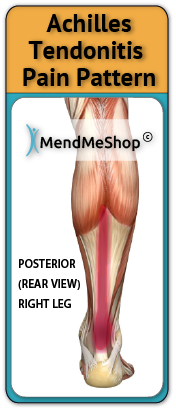
For acute (new or recent) tendon tears that have the ability to heal on their own - your doctor may even put a cast on your joint if the cast can keep the tendon at the level of extension that the doctor wants... or in a removable brace/splint. A removable splint can be very helpful to prepare you for PT sessions and mobility exercises.
Prolonged use of a cast, removable splint, or long-term rest (restricted movement) without proper exercise or stretching can make your Achilles tendon injury worse. If your Achilles tendon remains completely immobilized and at constant rest, the ends of the Achilles tendon (where it attaches to bone or other muscles) will begin to fill in with scar tissue as part of the healing process. You may also have on-going symptoms of pain, swelling and inflammation, and even poor blood flow circulation.
Lack of proper blood flow and growth of scar tissue will decrease the natural length of the tendon (atrophy) and tighten tissue, reducing the flexibility in the joint. Your ability to use this joint in taxing activities will become compromised. In summary, resting/casting/splinting of a compromised/injured tendon is good if done properly, but it is important to not rest it for too long as this will cause more issues related to atrophy.
There is a Unique Formula used for Recovery from Muscle Injuries...
We're going to let you in on a key piece of information... In every PT appointment they will usually use conservative treatments, massage, manual manipulation and/or stretching exercises to give you this Professional 3-Step Treatment Formula:
Step 1 - Warm Up Your Muscles

For this 1st step many physical therapists will use heat, manual manipulation, deep tissue massage, clinical ultrasound devices or a warm bath to warm up soft tissue in the injury area. The goal during this first step is to increase healthy blood flow circulation and relax the affected area.
'Warming up' the area will increase the elastic-nature of your muscle fibers making it much easier to stretch and when needed, hold the stretch. This will also extend the amount that you will be able to stretch your muscles.
Increase Your Blood Flow Circulation at Home
Use a TShellz Wrap® for 10 to 15 minutes at least half an hour before stretching. A TShellz Wrap® will promote blood flow to the affected area while warming up and relaxing the soft tissue. The TShellz® Circulatory Boost Wrap treatment will make your muscle fibers more elastic and pliable, allowing for more ease of movement when you're stretching and/or exercising. Continued treatment with a TShellz Wrap® will also deliver much-needed oxygen, nutrients and water (basically energy) to your hip. This will boost your own body's natural healing ability, helping speed up your recovery time.
Step 2 - Stretch
The main goal of PT is to exercise (stretch out) the affected joint to improve flexibility and range of motion. After the physical therapist has warmed up the joint, they'll get you to do a series of exercises that are focused on stretching out the muscles, tendons and ligaments.
Sometimes cardiovascular exercise, like using a stationary bike or treadmill, will be recommended under the supervision of your physical therapist.
Why are soft tissue injuries so hard to overcome? In two words -- scar tissue
Soft tissue is meant to be tough yet flexible, ready to work and move extreme forces in everyday activities. Damaged tissue heals with scar tissue - little tiny band-aids that overlap each other in and around the injury with the sole purpose of mending the injury. Unfortunately, scar tissue is quite rigid and inflexible; as a result you will feel the effects of scar tissue through stiffness, tightness, weakness and tiredness in the area. Scar tissue means you will lose flexibility and the joint will tighten up on you.
Scar tissue can form fast to bring together the edges of a tendon, ligament of the tissue tear, but working fast doesn't mean that the job's done right. When scar tissue forms it doesn't come together as neatly as regular (healthy) tissue would. Scar tissue fibers will lay down over top of your tear in a cluttered, messy and jumbled up way.
Stretching helps to break up scar tissue, ultimately reducing its troublesome effects on your body - yes, it is often quite painful but ultimately necessary to gain back flexibility. The goal is to minimize scar tissue growth and to do this we recommend that you be proactive in dealing with your muscle injury.
Step 3 - Cool Down
Toward the end of your appointment your physical therapist may introduce cold compression, acupuncture, or TENS to relax the affected area after intense stretching and exercise.

Our Muscle Formula Just Works!
It may seem hard to believe, but our TShellz Wraps®, ebooks and accessory products will assist you in recovering from your injury by reducing your swelling and inflammation induced pain, maximizing localized blood flow, and increasing the flexibility / range of motion in the area of application.
Here at AidMyMuscle we pride ourselves in helping you with your healing and recovery process. Everyone at AidMyMuscle has tested and used the products, finding solutions to conditions that do not fit into the norm. This dedication to our customers and our products goes hand-in-hand with our guarantees to you as a customer:
- Guarantee #1 - Use your products diligently for up to 60 days and you will experience a significant reduction in pain. If not, I encourage you to send back the items for a 100% refund.
- Guarantee #2 - You will not be left in the dark after purchasing any product from us. AidMyMuscle Advisers and Product Specialists are available Monday to Friday by toll free phone 1-866-237-9608 or email to answer your questions or concerns.
- Guarantee #3 - Your order is guaranteed to be shipped within 24 hours on every business day.
- Guarantee #4 - All purchases receive a one year, full replacement warranty with guaranteed, prompt service.
- Guarantee #5 - You could save hundreds of dollars and possibly more, by utilizing our products, and getting back to work sooner.
Product specialists are available 9:00 am to 5:00 pm Eastern Standard Time Monday to Friday.
If any question or concern arises, call us or simply send us an email at any time (we check our emails constantly all throughout the day and night.. even on holidays!). We will respond as soon as possible.
North America Toll Free 1-866-237-9608
Outside North America +1-705-532-1671
FREE SHIPPING ON ALL PRODUCTS CURRENTLY ENABLED
Please be aware that this information is neither intended nor implied to be a substitute for professional medical advice. All testimonials and comments reflect the real life experiences of individuals that used our products, however, individual results may vary. Always seek the advice of your physician or other qualified health provider before using any of our outstanding products to make sure they are right for you and your condition or if you have any questions regarding a medical condition.
For more information, call us via: 1-866-237-9608 or send us an email. View our Privacy Policy.
The terms Inferno Wrap®, Freezie Wrap®, T-Shellz® and Mendmeshop.com® are registered trademarks of In.Genu Design Group Inc.
All images shown are exclusive Copyright© 2006 - 2025 AidMyMuscle.com.
